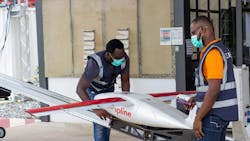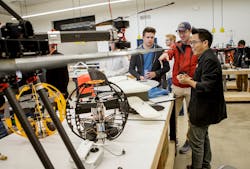UAV delivers COVID-19 test samples to labs in Ghana
In this week’s roundup from the Association for Unmanned Vehicle Systems International, which highlights some of the latest news and headlines in unmanned vehicles and robotics, the Zipline drone transports test samples from health care centers across Ghana, and a new UAV protective cage increases disaster response usefulness.
Drone delivery company Zipline tapped for Ghana COVID-19 sample flights
On-demand drone delivery specialist Zipline has been contracted by Ghana’s Ministry of Health to return COVID-19 test samples from health centers in the most remote areas of the country.
According to an official statement published on April 20, the U.S.-based company has already started to fly missions from four launch sites across the West African country to laboratory sites in Ghana’s Capital, Accra and second city Kumasi.
The "contactless" service will allow Ghana’s government to respond to the pandemic and help save lives "more quickly," according to a statement released by Zipline CEO Keller Rinaudo.
Zipline’s solution, developed in tandem with the U.S. Defense Innovation Unit and Naval Medical Research Center's Naval Advanced Medical Development (NMRC-NAMD), includes an autonomous launch and recovery system as well as Zipline drone.
The UAVS, which has a 3.3-meter (10.8 foot) wingspan, has been designed to carry payloads up to 4 pounds as far as 100 miles, company officials confirmed to Unmanned Systems. Operating at a top speed of 90 mph, the UAS is designed to parachute payloads onto a predesignated drop zone before returning to its launch location.
Each UAS includes redundant flight computers, motors, communications systems, flight controls, navigation and power systems. The drone, which can be controlled via GSM Cellular or Iridium Satellite communications signals, also features AES-128 encryption.
Speaking to Unmanned Systems, company spokesperson Justin Hamilton said Zipline is operating a total of four launch and recovery sites across Ghana, although additional expansion sites are planned.
Operations began on April 17 with COVID-19 test samples transported from rural health facilities to a distribution center in Omenako. Four sorties, each comprising 70-mile round trips, allowed Zipline to deliver 51 samples to the Noguchi Memorial Institute for Medical Research in Accra for testing and analysis.
Similarly, COVID-19 test samples are being flown 30 miles from the Mapong distribution center to the Kumasi Center for Collaborative Research.
Descended and disinfected
Deliveries of test sample bundles are made from the sky, with each drone descending to a predetermined and safe altitude above ground level before dropping the load (packaged in a reinforced container) by parachute onto a designated drop zone.
Before retrieval by medical staff, boxes are disinfected using a spray device. Each delivery includes approximately 30 test samples or more, according to Zipline.
Claiming this to be the first time UAS have been used to facilitate the delivery of COVID-19 test samples, Hamilton suggested the concept of operation would allow the Ghanaian government to “more closely monitor and respond to the spread of the disease in some of the country’s most remote and challenging to reach areas.”
“Before Zipline, COVID-19 test sample delivery could take many hours or many days for a delivery truck to collect a sufficient number of samples from rural hospitals and return them to the city.
“The time delay not only jeopardizes the government’s ability to respond swiftly but also increases the risk that samples can be damaged in transit due to broken cold-chain storage. Now, a single test from a rural area can be transported for analysis in under an hour,” he said.
Payloads are packaged in accordance with the World Health Organization’s Interim Laboratory Biosafety Guidelines for Handling and Processing Specimens Associated with Coronavirus Disease 2019. Zipline’s contract is expected to last “several years” with Ghana’s government, the company spokesperson added.
Furthermore, Zipline is ready to begin deliveries of personal protective equipment including face masks and gloves should it be deemed necessary by Ghana’s Ministry of Health.
U.S. support
As operations remain ongoing in Africa, Zipline is also in discussions to begin supporting COVID-19 operations in the United States.
“We plan to launch commercial operations in the fall, and we are in conversations to begin emergency operations within weeks of receiving the green light,” Hamilton said.
Initial support is likely to include deliveries to hospitals as well as patients’ homes around the country.
"The company believes that COVID-19 presents such an imminent threat to the country that it is prepared to begin emergency humanitarian operations right away," says the company statement.
“Zipline’s emergency efforts in the U.S. would focus on distributing scarce resources like test samples and personal protective equipment across health systems more efficiently and effectively. The company can also help keep vulnerable non-COVID-19 patients with chronic and underlying conditions away from hospitals- both to prevent exposure and to keep them from overwhelming the system by delivering care to where they live,” the statement says.
Zipline UAS could also be used to distribute COVID-19 vaccines as and when they become available, Hamilton added.
Zipline continues to cooperate with the Federal Aviation Administration to facilitate such a concept of operation in the United States.
Zipline’s support of medical operations in Africa follows its deployment with U.S. and Australian armed forces on multiple exercises between July 30 and Sept. 5, 2019. UAS were deployed to deliver medical supplies, including fresh whole blood and water resupply across the battlefield in support of the U.S. Marine Corps and Australian Defence Force.
According to Hamilton, the exercise demonstrated the ability of the network to support a “logistics network of autonomous delivery drones to help transform emergency medicine and critical care in conflict, as well as in humanitarian and disaster relief scenarios.”
OSU's new drone designed to keep rescuers out of harm's way following disasters
The aftermath of the Oklahoma City bombing in 1995 that left 168 people dead sparked the work being done today by Oklahoma State University’s (OSU) Unmanned Systems Research Institute to help first responders.
25 years ago, there was no technology available that could help rescuers locate victims without risking their own lives to climb throughout what was left of the Murrah Building.
With this in mind, the now deceased Jon Hansen of the Oklahoma City Fire Department said that first responders needed a better way to conduct searches of rooms and communicate with the injured without having rescuers climbing through an unstable structure.
This led Dr. Ben Loh, USRI graduate and research engineer, to creating a drone encased in a protective cage called All Terrain Land and Air Sphere (ATLAS). OSU notes that typical drones have exposed propellers and require a coordinated landing. If the drone turns over, it can’t right itself.
“With something like the Murrah bombing scene, most exposed propeller platforms like a quadcopter can easily get caught by the debris or dangling wires in the building,” Loh explains.
“A quadcopter without a prop guard could accidentally hit an obstacle and flip over. This could mean the end of the mission since it cannot recover to flight.”
Thanks to ATLAS’ spherical cage, propellers are protected from debris, and people are protected from the propellers.
“The spherical frame can endure an uncoordinated landing. The cage allows … ATLAS to roll away from obstacles and recover to flight,” Loh says.
One of ATLAS’ key features is its ability to land in uneven terrain. If the propellers are stopped, rescuers have a better chance of communicating with victims.
“Noise from the propellers is always an issue if using a microphone to pick up the victim's voice at a disaster area,” Loh says. “One way to overcome that is to land the vehicle to stop the propeller.”
To improve the drone’s battery life, Loh has been working on reducing the weight and size from 17 inches to 13 inches. While optimized for indoor operations, the drone can also be used during outdoor missions as well.
“The research is ongoing to make ATLAS more efficient as battery (power) remains the limitation for most drones today,” Loh says.
ATLAS is designed to carry a payload specific to the mission, such as cameras, CO2 sensors and lidar. Loh has also created an affordable version of the drone for STEM teachers in elementary and secondary education that has a foam-board cage.
To get feedback on the project, Loh has met with fire departments, emergency managers and other potential customers. OSU says that the design is ready for testing at the next natural or man-made disaster.
“The ability to design and develop these systems to not only assist first responders, but potentially save lives, really targets OSU’s mission as a land-grant university,” says Dr. Jamey Jacob, director of the Unmanned Systems Research Institute. “What serves the public good more than helping those who help others?”
Compiled by Brian Sprowl, Associate Editor, AUVSI
Share your vision-related news by contacting Dennis Scimeca, Associate Editor, Vision Systems Design
SUBSCRIBE TO OUR NEWSLETTERS

